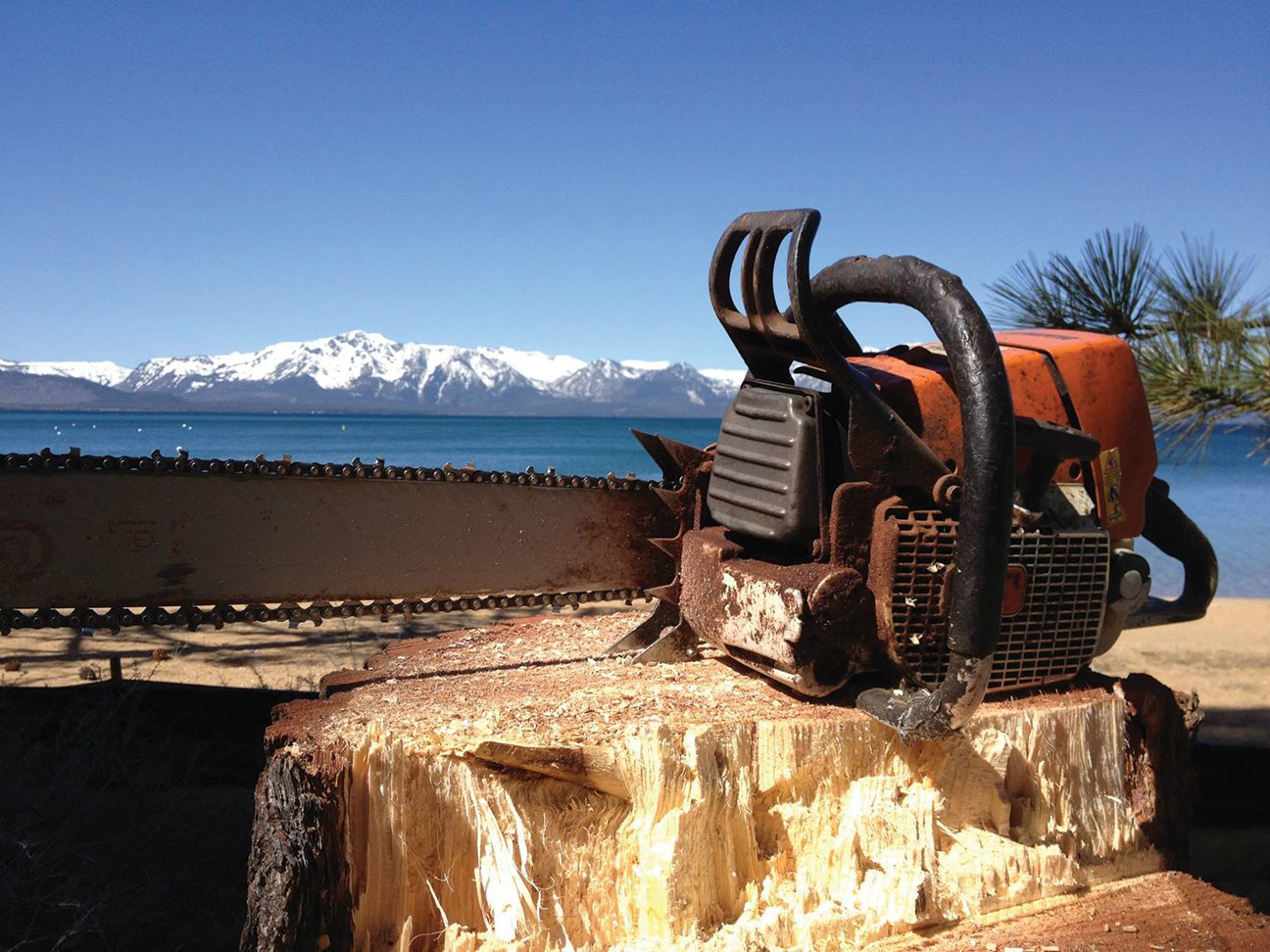
27 Sep Collecting Fuel for the Fire
Romanticized qualities aside, wood fires remain a valuable source of heat in the Tahoe region, requiring residents to know the best practices and products available
Radiant yellow and orange flames leap from what is potentially the world’s most popular wood fire. Its rough-hewn logs are etched with signs of its ashen fate, and it has that familiar pleasant crackle. But this fire puts out no heat, has no smell and requires an Internet connection. The 10-hour video of a fire burning in a fireplace has more than 136 million views on YouTube and represents a very twenty-first-century way to experience something primordial.
Yet, even when engaging only two of peoples’ five senses, wood fires have a way of holding our attention.
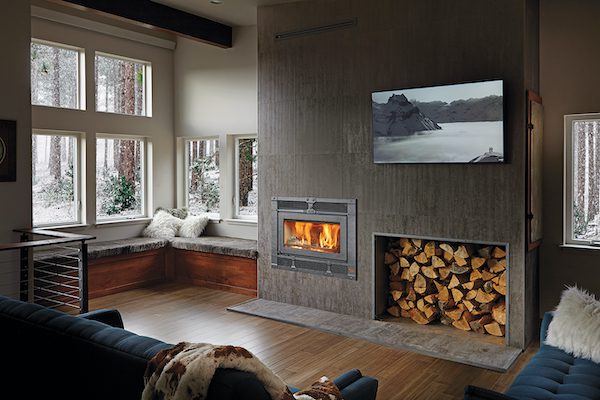
In traditional and modern homes alike, fireplaces and woodstoves retain their place among the coziest and most affordable forms of heat available, photo courtesy Mountain Home Center
Many Tahoe residents would argue that the age-old means of heating a home holds far too much of their attention, as the annual process of locating, cutting, transporting, splitting, stacking and storing firewood can require groan-inducing amounts of time and effort.
For others, a wood fire simply represents an occasional enterprise providing unmatched ambiance and a way to bring people together in warmth of body and spirit. There just seems to be something about the coziness of a fire—the safe, contained variety, of course—that has earned it a top place among the most romanticized occurrences of mountain life.
“When there’s a blizzard going on and you have a wood fire going in your stove, it’s pretty magic,” says Frank Cody, owner of Cody’s Tree Service in South Lake Tahoe.
Conjuring that magic takes some wizarding. From wood selection to fire-building techniques to health and safety to options outside the traditional woodstove, residents and visitors to the Sierra Nevada have a lot to consider. Luckily, the area is ripe with knowledge from years of experience in all things firewood.
“It’s a beautiful medium to really get in touch with your environment,” says Floriston resident Tom Loeschner, a longtime woodworker and creator of Greywood Design, who grew up helping his father collect firewood in Incline Village. “There’s the whole farm-to-table concept. And this is the same idea.”
One Wood, Two Wood, Softwood, Hardwood
The forests around Tahoe and Truckee are chock full of pine and fir, with pine being the most readily available firewood. Considered a softwood, pine tends to light easier and burn faster than denser hardwoods like oak and almond, which grow at lower elevations in the Sierra foothills and Central Valley.
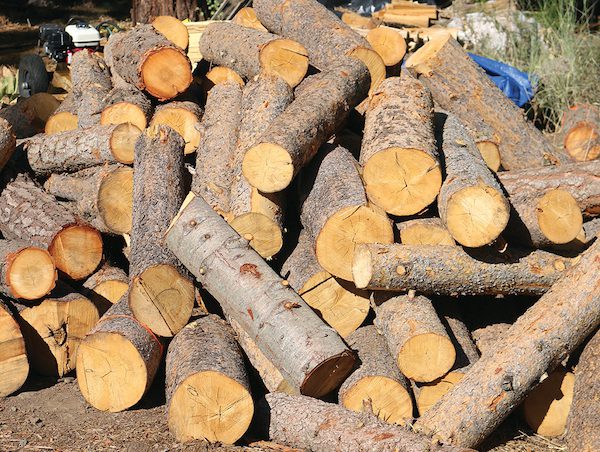
Lodgepole pine and fir await further cutting and splitting in a Glenshire neighborhood, photo by Sylas Wright
Lodgepole pine is among the most sought-after softwoods available, attractive for its light weight, thin bark, minimal ash and generous heat. While ponderosa and Jeffrey pine, along with white and red fir, will heat a home just fine, they tend to have thicker bark than lodgepole, which can be messier and potentially create additional soot, Loeschner says.
Jason Kosich, owner of Truckee’s Kosich Firewood & Tree Service, says the faster-burning softwoods are good fuels for those seeking quick heat and a little ambiance, while the hardwoods like oak burn slower and can provide heat throughout the night under the right conditions. (Other hardwood examples include madrone, manzanita, alder, ash, aspen, birch, cottonwood, maple and fruit trees, among others.)
Customers will often get a combination of hardwoods and softwoods to personalize their fires depending on their needs, Kosich says, adding that each wood variety provides a desirable experience when used properly.
“It just feels like a nicer heat than forced air,” Kosich says of a proper wood fire.
The University of Nebraska-Lincoln Extension and Utah State University Forestry Extension have both studied the characteristics of dozens of types of firewood, publishing free resources online that parse weight, heat per cord, percent of green ash, ease of splitting, smoke, sparks, coals, fragrance and overall quality.
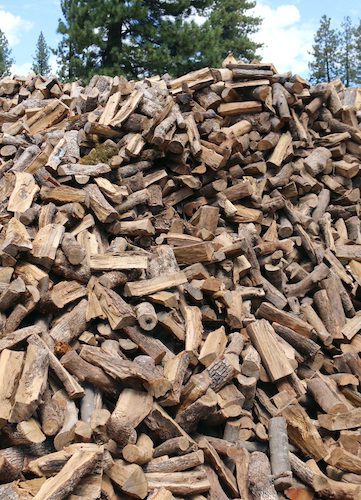
A large pile of hardwood ready for delivery at Truckee’s Kosich Firewood & Tree Service, photo by Sylas Wright
Pine varieties are noted as easy to split with a good fragrance and fair overall quality. The 21.1 million British thermal units (Btus) per cord for lodgepole pine performs better than many on the list but can’t quite compare to the power packed in hardwoods like apple (27.0 million BTUs per cord) or oak (26.2 to 30.7 million BTUs per cord). Hardwoods are more difficult to split but also create a more desirable bed of coals, according to the universities’ studies.
Prices for firewood vary, but generally run between $300 and $350 per cord for softwoods and around $500 per cord for hardwoods, which are not always available in the Tahoe area. A cord is defined as a well-stacked pile measuring 4 feet by 4 feet by 8 feet. How much wood a household needs for a winter can range anywhere from two to 10 cords, depending on the size of the house, frequency of fires, outdoor temperatures and efficiency of the fireplace or woodstove.
Abundant availability and the relatively low cost per unit of heat are among the reasons the demand for firewood in the Tahoe region has remained relatively steady year after year, says Cody.
“It’s really consistent,” he says. “It hasn’t ever really slowed down that I’ve seen in my life.”
For those looking for a more authentic mountain experience complete with added pioneer vibes, cutting permits are available from the Tahoe National Forest and Lake Tahoe Basin Management Unit. The Lake Tahoe Basin wood-cutting season typically opens in May or June, while the Tahoe National Forest’s Truckee Ranger District season starts in late April and runs through December. When obtaining a permit, woodcutters are given a map designating allowed areas, which vary slightly depending on forest closures or ongoing projects. Cords harvested from the Truckee Ranger District are $15, with a two-cord minimum.
For Cody, using an abundant natural resource locally makes a lot of sense. He says he’ll typically sell out of firewood by October and encourages people to plan ahead for their fuel needs. Kosich says that, while certain varieties of wood may run low when demand is at its peak in early fall, Kosich Firewood & Tree Service has wood available year-round.
Tips and Tricks for Burning it Best
After wood has been collected, there are numerous ways to make a winter fire a more pleasurable experience.
“The art of firewood is to figure out how to touch it as little as possible,” Loeschner says.
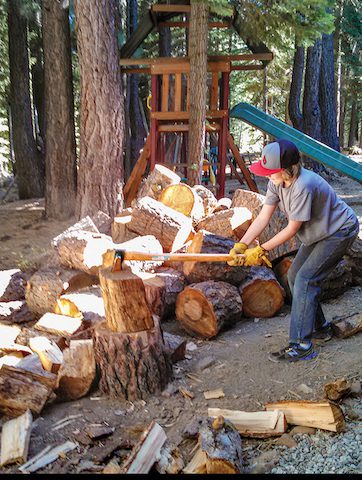
Kane Thompson learns the value of hard work at an early age, photo by Scott Thompson
Splitting and stacking firewood can be hard on peoples’ bodies, so Loeschner splits wood on his knees to limit repetitive back bending. Anything that can be rolled should be rolled, he says, noting he also deploys a hookaroon, essentially an ax handle with a stout pick on the end, to assist in moving rounds. Typically, the less one has to move wood, the happier they’re going to be.
“Wood burning is a commitment,” says Tom Just, owner of Truckee’s Mountain Home Center, who, as a longtime mountain resident, has plenty of experience in the firewood realm. “I would handle each piece of wood approximately 10 times from bucking, splitting, stacking, kindling, fire building, ash handling, et cetera. But the heat is unmatched, and the cost per million BTUs is awesome if you work for it.”
Looking beyond the trunk of a tree is also a less heralded way of creating a great fire without as much work, Loeschner says. “Tahoe gold, for me, is branch wood,” he says, explaining that branches are dense, provide ample heat for their weight and don’t require as much effort as rounds.
Regardless of the type of wood chosen, properly seasoning it to remove excess moisture is key to a top-notch fire. Well-seasoned wood creates a hotter, more efficient and cleaner-burning fire that generates fewer byproducts.
“The second art of firewood is getting dry wood,” Loeschner says.
The U.S. Environmental Protection Agency (EPA) recommends thoroughly splitting and storing firewood off the ground for at least six months prior to burning. Bringing wood inside the day before it’s burned, building fires so they get enough oxygen to fully combust and checking to see that a chimney is not putting out plumes of excess smoke are also among the EPA’s tips for an efficient fire. Short, hot fires reduce creosote creation and decrease the amount of air pollution generated through wood burning.
“If there’s thick smoke pouring out of the chimney, there’s probably something not quite right with the wood,” Cody says.
Wood Smoke, Health and Safety
Keeping air quality from diminishing due to the impacts of smoke has been a push by agencies across the U.S., as the particulate matter created by wood fires can cause illness, as well as trigger some health conditions.
Replacing older woodstoves with newer, more efficient models can significantly decrease wood smoke pollution and provide cost savings in the long run.
“With an EPA-certified woodstove, you can expect to use up to one-third less firewood than you would using an older, less efficient stove,” according to the EPA. “The smoke that you see coming out of the chimney is really lost energy. In an EPA-certified stove, most of the smoke is burned, resulting in more heat for your home from the same amount of wood.”
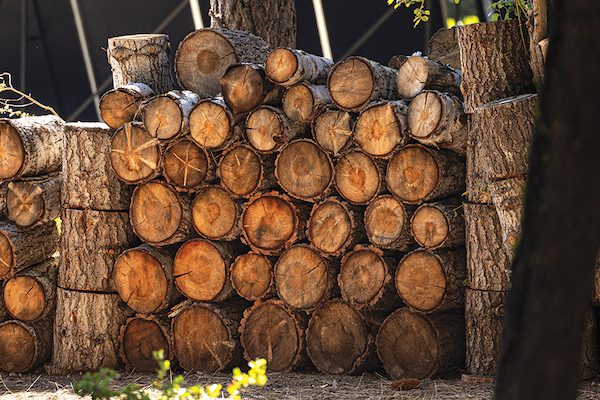
Rounds of firewood in a Tahoe Vista neighborhood. Due to the increasing risks of wildfires, defensible space guidelines recommend stacking firewood off the ground with a non-combustible surface underneath, photo by Ryan Salm
Requirements for wood-burning devices vary between California and Nevada, as well as local jurisdictions. Just urges those building, buying or remodeling a home to check with their local building department about specific restrictions on wood-burning devices. Rebates are sometimes available for replacement of older fireplaces and woodstoves.
The Tahoe Regional Planning Agency (TRPA) has worked in recent years to get older wood-burning stoves in the Tahoe Basin replaced. The TRPA’s Wood Heater Retrofit program requires all existing wood heaters, excluding legally existing open woodstoves, to meet certain emission standards before a building transfers ownership.
Inversion layers can trap air pollution in the Tahoe Basin, and limiting burning, when possible, to times that smoke can be carried up and out of an area helps keep the skies clearer.
“Winter days in the Basin used to have quite a haze, and the action of trapped air masses called atmospheric inversion layers will concentrate smoke close to the ground and the lake’s surface, resulting in elevated pollution levels, poor visibility and declined lake clarity,” says TRPA spokesman Jeff Cowen.
Wildfire is also a concern when it comes to storing firewood. As part of defensible space requirements, state and local agencies require firewood to be kept at least 30 feet from structures. Exposed wood piles should also be at least 10 feet from all surroundings, according to defensible space guidelines.
Failing to regularly remove leaves or pine needles from woodpiles and improperly storing wood directly on the ground, where it’s susceptible to rot and can create a continuous fuel bed capable of transferring wildfire, are among the discouraged practices fire officials often see in the region, says Nathan Menth, fire captain for Cal Fire’s Nevada-Yuba-Placer Unit. Ideally, in addition to being off the ground with a non-combustible surface underneath, a woodpile would be wrapped up “like a Christmas present” in a fire-resistant tarp, Menth adds.
Options Abound, Appeal Endures
Despite the continued allure of wood fires, gas-burning devices make up most of the demand from customers at Mountain Home Center, Just says. Gas-burning fireplaces, stoves and inserts come in all shapes, sizes and styles. Potentially a little less charm combined with a lot more convenience can be hard to deny.
Mark Tanner of Truckee’s Mark Tanner Construction remodeled his home a couple of years ago, replacing a wood-burning fireplace with a gas insert. While the crackle and aroma are gone, the “instantaneous gratification” has kept him from getting too sentimental about wood fires.
“You don’t have to be a Boy Scout,” Tanner says of the new setup. “It’s a whole lot easier to push a button and see the fire.”
Electric fireplaces, featuring LED flames, and pellet stoves and inserts, which burn compressed cylinders of wood products, round out some of the woodstove- and fireplace-inspired home heating options available.
Although they remain in the minority of purchases locally, wood-burning devices have seen a recent, if slight, uptick, Just says. Even with stiff competition and their potential challenges, wood-burning has shown enduring appeal.
“Burning wood is one of the few ways we tap into our primordial past,” Loeschner says. “The advent of fire was part of the advent of humanity and civilization. As soon as we started fire, it opened up a whole new gateway to where we went.”
Wood-burning is also just a fact of life for many in the Sierra Nevada and still provides the best value for those willing to put in the work. As eloquently as he speaks of firewood, Loeschner says he is less enamored than he once was.
“I’ve lost the ambiance; it’s just that I’m not going to pay for my heat,” Loeschner says, acknowledging that after all the cutting, splitting, stacking, building and burning, wood fires have a unique effect on people that other sources can’t quite match.
“Nobody is excited to hear the furnace turn on,” he says.
Adam Jensen is a former South Lake Tahoe-based journalist living in the Central Valley.




No Comments